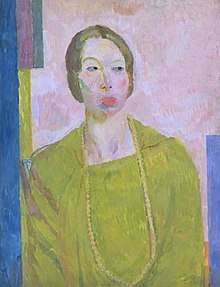Mary Hutchinson (writer)
Mary Hutchinson (née Barnes; March 1889 – 1977) was a short-story writer, socialite, model and a member of the Bloomsbury Group.
Early life
Hutchinson was born in India in 1889 to Sir Hugh Barnes and Winifred Strachey Barnes. After spending her early childhood in India, she was raised in Florence, Italy by her maternal grandparents, and later attended boarding school in England. Hutchinson moved to London in 1909 and in 1910 married barrister St John Hutchinson. Their marriage lasted until his death in 1942.[1] They had two children, Jeremy Hutchinson, Baron Hutchinson of Lullington and Barbara Judith, who later married Victor Rothschild, 3rd Baron Rothschild.[2]
Bloomsbury Group
In 1910, her cousin Lytton Strachey and Duncan Grant introduced her to the Bloomsbury Group.[1] Hutchinson eventually became a hostess and patroness, hosting lavish soirees at her two homes, Eleanor House and River House. In 1927, influenced by the Group's writers, Hutchinson published a single volume of thirteen articles and six short stories entitled Fugitive Pieces.[3] Throughout her life, she attracted a group of writers and painters to her house, where she and her husband entertained, among others, Mark Gertler, Edward Kauffer,T. S. Eliot, Aldous Huxley, and Virginia Woolf.[4] Hermione Lee asserts in her biography of Virginia Woolf that Hutchinson was the "main inspiration for the febrile socialite Jinny in The Waves."[5]
Art model

Hutchinson often posed as a model for painters. In 1915, Vanessa Bell painted an unflattering portrait of her called Mrs. St. John Hutchinson, describing it as "perfectly hideous... and yet quite recognizable."[6] Hutchinson also posed for two of Bell's paintings, Nude with Poppies (1916), which Bell painted for Hutchinson, and The Tub.[7]
Clive Bell introduced her to Henri Matisse, who drew her portrait twice in 1936, both charcoal drawings entitled Portrait of Mary Hutchinson.[4]
In the early 1930's, Russian artist Boris Anrep used her as a model for Erato, the muse of lyric poetry, in The Awakening of the Muses mosaic in the entrance hall of the National Gallery in London.[3]
Personal life
Although married until her husband's death in 1942, Hutchinson had many lovers, many of whom were part of, or in contact with, the Bloomsbury Group. She maintained a long term, indiscreet affair with Clive Bell from 1914 until 1927, who was married to fellow Bloomsbury Group member Vanessa Bell.[3] On the other hand, her letters suggest that she maintained a similarly long term relationship from 1922 to 1930 with Aldous Huxley and his wife, Maria, although this was kept secret from the Bloomsbury Group and from Jack Hutchinson.[1] Hutchinson also had brief liaisons with Vita Sackville-West and Matisse's son-in-law, Georges Duthuit.[3] Mary Hutchinson and Virginia Woolf were intimate friends; however, it is unclear to what extent it was a love affair or merely a friendship.
Hutchinson and T.S. Eliot also maintained a close correspondence from 1916 until the last months of his life.[3] She was also an early supporter of Samuel Beckett and corresponded with him throughout his career. Hutchinson was also interested in fashion and interior design, and remained an active patron of the arts throughout her life. She supported the publication of the literary and artistic magazine, X.[1]
References
- 1 2 3 4 "Mary Hutchinson: An Inventory of Her Papers at the Harry Ransom Humanities Research Center". www.lib.utexas.edu. Retrieved 17 November 2017.
- ↑ ‘HUTCHINSON, St John’, Who Was Who, A & C Black, an imprint of Bloomsbury Publishing plc, 1920–2007; online edn, Oxford University Press, Dec 2012 ; online edn, Oct 2012 accessed 16 November 2017
- 1 2 3 4 5 Nancy D. Hargrove (22 September 2011). "The Remarkable Relationship of T. S. Eliot and Mary Hutchinson". Yeats Eliot Review. 28 (3–4). ISSN 0704-5700.
- 1 2 "Matisse in England and Two English Sitters on JSTOR". JSTOR 885558.
- ↑ Hermione Lee (1999). Virginia Woolf (1st Vintage books ed.). New York: Vintage Books. ISBN 0375701362.
- ↑ Tate. "'Mrs St John Hutchinson', Vanessa Bell, 1915". Tate. Retrieved 17 November 2017.
- ↑ Fiona MacCarthy (23 October 1999). "A radical regained". The Guardian. ISSN 0261-3077. Retrieved 17 November 2017.